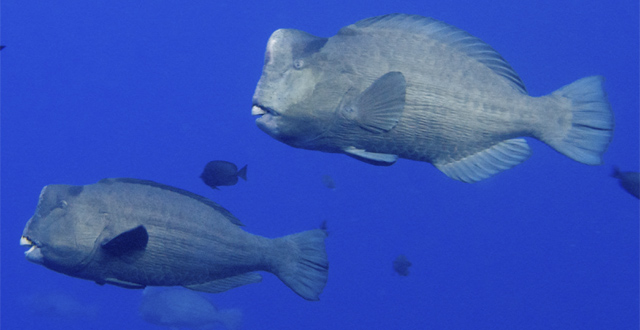Reproduction
Most
parrotfishes are protogynous hermaphrodites (R. J Hamilton et
al. 2008; Encyclopedia of Aquatic World et al. 2011). This is
because these fish form a group with one male and many females,
which means that if the male dies the dominant female will
undergo a sex change (five day change) to become the dominant
male (R. J Hamilton et al. 2008; Robertson et al 1978). Unlike
most parrotfishes the Bolbometopon muricatum is said to be
gonochoristic or protogynous hermaphrodites which means that the
sexes are separate but there is a branch that allows a secondary
male to become female or become a primary male. Because of this
pattern most parrotfish begin as female and undergo a sex change
to become male (R. J Hamilton et al. 2008). The males that can
change are called secondary males as they are bisexual for one
part of their life before changing into a primary male. When the
males possess hermaphroditic qualities a pre-reproductive period
takes place that makes physiological changes required to become
a male when the dominant male dies, or leaves the group (R. J
Hamilton et al. 2008; Dive the World 2012).
Reproduction then can
occur once both sexes reach sexual maturity. After the
change the male undergoes they will continue to grow to reach
sexual maturity around the age of 5-7 years. During this time
females are continuing to grow to reach maturity around the age
of 9-11 years (R. J Hamilton et al. 2008). This time is
different because there is a high demand of males and they grow
faster than females. When both male and female reach maturity
spawning can occur throughout the year if conditions are stable
and productive. Spawning usually occurs in the morning in reef
passages (Kobayashi et al. 2011). Refer to
Habitat page for more
details. Courtship and pelagic
spawning activities occur during the early morning and eggs are
laid in shallow grooves often by aquatic plants. These plants are used to protect and camouflage the eggs from being eaten by
predators. After they hatch the newly-hatched offspring often
times stay in this secluded area for up to a year to grow and
mature before joining the adults in the reefs (Kobayashi et al.
2011).
To navigate to our home page simply press Home located at the bottom of every page, or continue to the Interactions page.
